Film Room: Looking at how UVa's offense uses pre-snap motion
Editor’s Note: This is the 11th installment in our summer series breaking down UVa’s schemes, concepts, and personnel as the Hoos head toward the fall and presumably the 2020 football season. You can check out our first piece here, which focuses on the tight end position, our second right here, which focuses on the QB battle to come, our third piece here that breaks down the way UVa uses quarterback runs, our fourth piece here which looks at UVa's outstanding OLBs, our fifth piece here which looks at the impressive depth on the D-line, our sixth piece here which focuses on the rotation at inside linebacker, our seventh piece here which takes a look at UVa's options at running back, our eighth piece here which focused on the leap that Terrell Jana took as a junior, our ninth piece here which looked at UVa's other options at receiver, and the 10th piece here which focused on the transfers on offense.
Spreading the Defense
Today we're going to dive into how UVa's offense uses pre-snap motion to give the Cavaliers leverage. We'll start with a break down of how it spreads the defense.
On this first play, against William and Mary, Chris Sharp is lined up in the backfield after the Cavaliers break the huddle. He goes in motion out wide to the right. And by wide, we mean really, really wide. Sharp is almost on the Tribe bench by the time he come set.
Notice how that motion impacts the W&M defense. The Tribe are forced to cover Sharp out wide, with a DB following him out to the edge, rather than covering UVa’s tight trips set off the right side of the line. The safety drops out of the picture after motion, and UVa now has three receivers in trips against two defenders.
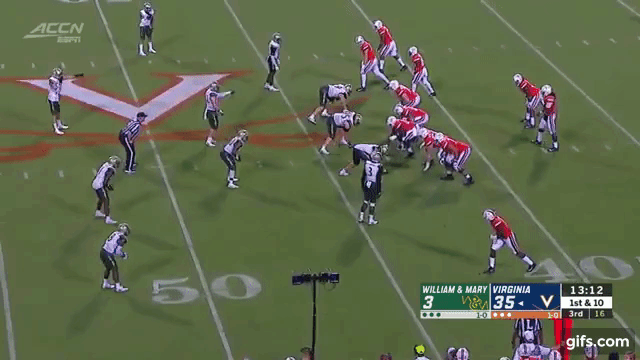
Below is the result of that defensive shift. Virginia’s three receivers in trips run routes in different directions, splitting the defenders. Since UVa has a three against two, and Bryce Perkins knows the routes are short ones, he has an easy throw to make.
On this play, he quickly identifies Terrell Jana as the free receiver, running a quick hitch route. Easy throw, easy catch, nice gain for UVa.
Without the pre-snap motion, UVa has three receivers on three defenders, and rather than having an open man, one of the receivers would have to win a route before pressure arrives for Perkins to complete the pass.
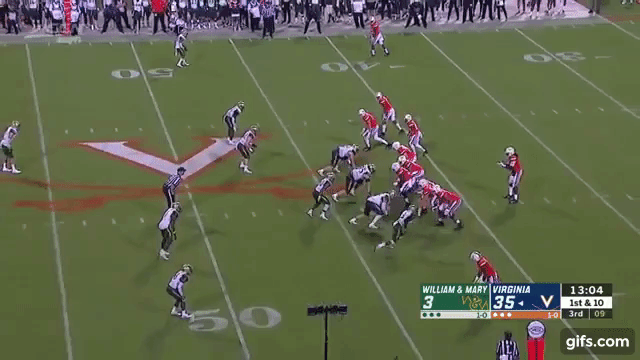
The next play is similar, with Lamont Atkins going in motion wide right. On this play, rather than leaving a receiver open, Duke’s coverage shift creates a mismatch. A defensive back follows Atkins out wide, which forces the defense to change alignment.
As a result, Joe Reed is lined up one-on-one with a linebacker, a matchup that he is going to win every time. Perkins sees this and is decisive with his throw. This ended up being an easy play and a nice gain.
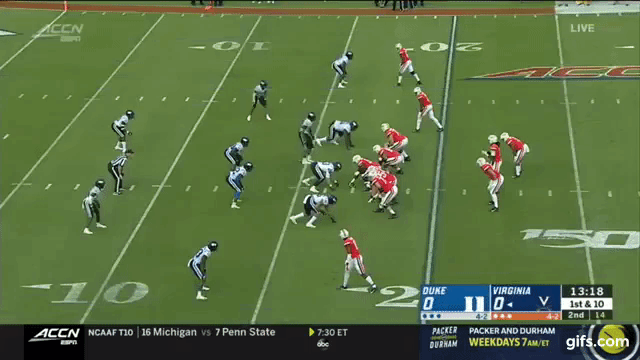
The final example of this sort of motion features Wayne Taulapapa going wide left against Clemson. Again, UVa has a tight trips package and runs basically the same route concept they ran on the previous example against William & Mary.
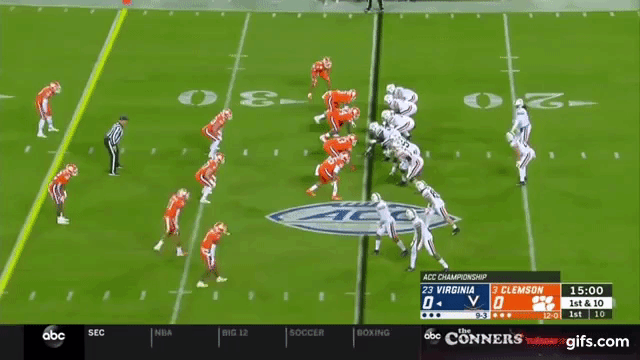
Clemson covers the play better but even with three defenders against three receivers Perkins was able to hit Hasise Dubois on a quick hitch before the safety can close in and make the tackle.

Reading the Defense
Virginia’s pre-snap motion doesn’t always create mismatches or put three receivers on two defenders. It also creates confusion for the defense and clarity for the quarterback.
Here is a play against Florida State where UVa motions the Seminoles into confusion, creating an easy throw. First, the Cavaliers moves Atkins from the slot into the backfield and Dubois out wide. FSU’s defense processes the movement but don’t really adjust.
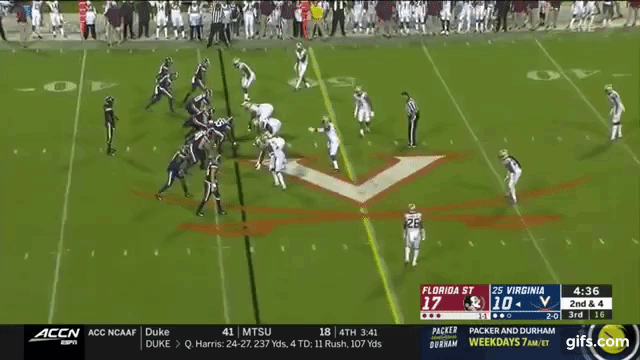
Then UVa sends Tavares Kelly in motion from left to right, and no defender comes with him. The formation at the snap looks nothing like what the Hoos came out of the huddle in, but FSU’s defense has made minimal adjustments of its own.
It could be miscommunication but likely the Noles knew they were going to run zone coverage and their lack of movement tells Perkins the same thing. He has one defender covering Jana in the slot and Atkins out of the backfield. The defender gets caught in between the two, and Perkins can make an easy throw to Jana.
UVa ran this type of play over and over again in the second half of this game, and simply took what FSU gave, dinking and dunking down the field for three scoring drives in the fourth quarter.
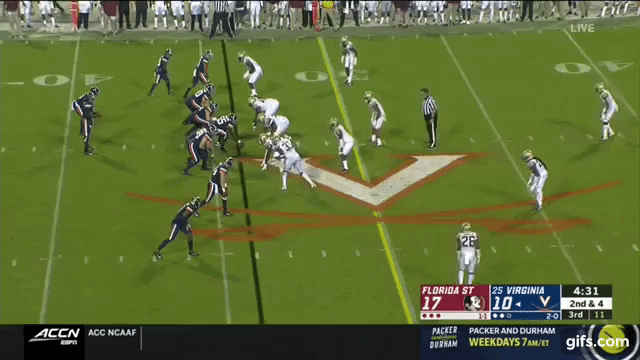
This next play is a bit more straightforward. Kelly goes in motion again and nobody goes with him. The safety on that side does shade over towards Kelly and Jana, but isn’t particularly close to the line of scrimmage.
Perkins knows that Kelly is turning towards him for a screen and that there is no way the help defender can get there before the ball does, as long as Jana doesn’t whiff badly on a block.
ODU’s third defender (#23) does a great job recognizing the play after the snap, and keeps Kelly from making what could’ve been a big gain. Still, the play design makes sense, and although it didn’t yield a big gain it’s an easy play that has high potential.
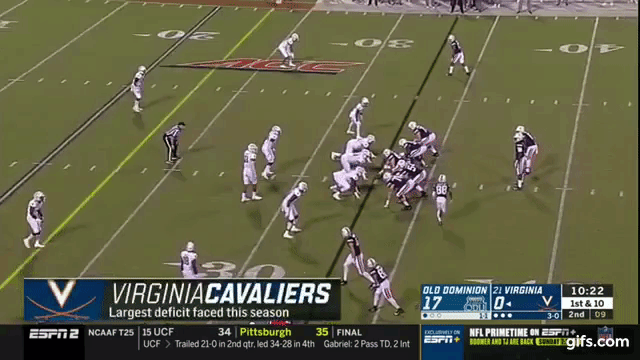
The next play doesn’t result in a lot of confusion from the Notre Dame defense but it’s a concept that UVa runs a lot.
Dubois goes in motion and once he’s inside of Jana in the slot, he cuts in towards the middle of the field, running a drag route. This can cause some confusion with the defense as the motion forces the defenders to shift or adjust who is covering which receiver in man coverage or create a sort of pick play with Jana cutting off the outside defender who would be chasing Dubois towards the middle.
The Irish run zone here and, like with the FSU play, the defender gets caught between covering Jana’s hitch route and taking the back out of the backfield. The result is a quick throw and catch.
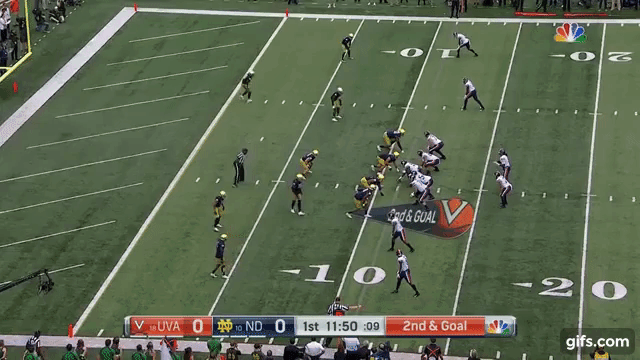
Creating One-on-Ones
Finally, UVa uses pre-snap motion to create one-on-one matchups on one side of the field.
Virginia threw a good number of jump balls to Dubois both last year and the year prior, knowing that he was adept at winning those and hauling in a tough catch. In order to ensure he has room to work one-on-one without any help defenders, UVa would often line up a receiver on that side and then run him in motion. If the opposing team is playing man coverage, that leaves Dubois on an island with the defender.
On this first example against Duke, Reed goes in motion and the safety lined up opposite him drops back into the middle of the field. Dubois is working on the sideline and has a single-coverage matchup with no help. He fights through coverage and makes a tough grab.
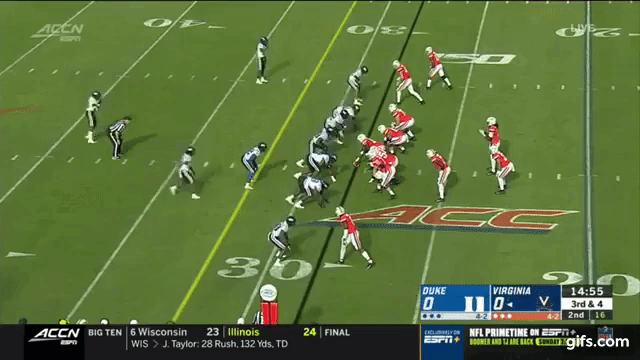
A successful blitz from UNC blows this play up but the concept makes sense. Reed again goes in motion in the red zone, giving Perkins a shot to connect with UVa’s top red-zone target in Dubois.
The throw was rushed and off the mark because of pressure but the play was designed to give Dubois a jump ball attempt and they almost pull it off. The Wahoos would come back to a similar play (without motion) later in the quarter and score a touchdown.

Final Thoughts
Virginia’s short passing game was such a big part of its offense last season and that trend isn’t likely to change in 2020. Jana’s emergence in the back half of the year was largely due to his success finding openings in zone coverage on short routes and the scheme helping him to do that. Pre-snap motion was very effective at shifting defenses out of what they wanted to run or potentially creating confusion and allowing receivers to run free, or giving them a mismatch.
There are plenty of other passing plays that include pre-snap motion plays not highlighted in this piece. Check out our breakdown of Kelly and Billy Kemp for more, as many of their screens and short passing plays included pre-snap motion getting them into those routes.
UVa’s schemes should still be effective this season and Brennan Armstrong has demonstrated the ability to read defenses pre-snap and get the ball out quickly. The big question for the Hoos this season is whether they have players that can turn these short catches created by mismatches and defensive confusion into long gains or touchdowns.
JOIN CAVSCORNER TODAY!
If you are not already a member of CavsCorner, come join us and see what all of the buzz is about.
Click HERE to subscribe and get all of the latest news and join hundreds of other UVa fans in talking about Cavalier football, basketball, and recruiting. You won't be disappointed!
